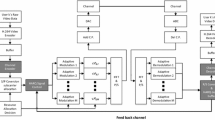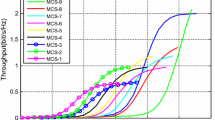Abstract
Since the basic objective of all communication systems is to provide a high-quality performance, the development of effective retransmission schemes with incremental redundancy has gained significant importance recently. In this regard, two retransmission mechanisms had been addressed the hybrid-automatic repeat request (HARQ) and the new smart hybrid-automatic repeat request (SHARQ); thus, SHARQ is integrated with an autonomous retransmission method, ensuring the transmission of a data packet regardless to the successful decoding of the packet at the receivers. That is to say, in order to make sure of having a maximum spectral efficiency, this mechanism determines the required optimal number of autonomous retransmissions. In other words, the developed system means to guarantee the benefits of the SHARQ mechanism based on the LTE-A network as well as the output improvement from the SHARQ. Furthermore, in this current research paper, according to a new proposed algorithm a comparison will provided between the most two basic newest retransmission mechanisms over the LTE-A. Thus, through the use of the OPNET Simulator 17.5, it found out that the SHARQ mechanism is much better for the system’s operation, compared to the HARQ mechanism; not to mention that it is the best choice for all multimedia services as well as the overall network performance.
























Similar content being viewed by others
References
Khosravirad, S. R., & Viswanathan, H. (2018, April). Backwards composite feedback for configurable ultra-reliability of retransmission protocols. In 2018 IEEE wireless communications and networking conference (WCNC) (pp. 1–6). IEEE.
Kuhn, N., Lochin, E., Lacan, J., Boreli, R., & Clarac, L. (2015). On the impact of link layer retransmission schemes on TCP over 4G satellite links. International Journal of Satellite Communications and Networking,33(1), 19–42.
Vukobratović, D., Khirallah, C., Stanković, V., & Thompson, J. S. (2014). Random network coding for multimedia delivery services in LTE/LTE-advanced. IEEE Transactions on Multimedia,16(1), 277–282.
Mukhtar, H., Al-Dweik, A., Al-Mualla, M., & Shami, A. (2015). Low complexity power optimization algorithm for multimedia transmission over wireless networks. IEEE Journal of Selected Topics in Signal Processing,9(1), 113–124.
Zhu, C., Huo, Y., Zhang, B., Zhang, R., El-Hajjar, M., & Hanzo, L. (2016). Adaptive-truncated-HARQ-aided layered video streaming relying on interlayer FEC coding. IEEE Transactions on Vehicular Technology,65(3), 1506–1521.
Kim, S. H., Chaitanya, T. V., & Le-Ngoc, T. (2016, May). HARQ with chase-combining (HARQ-CC) for uplink transmission in large-antenna-array multicell systems. In 2016 IEEE 83rd vehicular technology conference (VTC Spring) (pp. 1–5). IEEE.
Jung, Y. H., & Choi, J. (2017). Hybrid ARQ scheme with autonomous retransmission for multicasting in wireless sensor networks. Sensors,17(3), 463.
Shi, Z., Ma, S., Yang, G., & Alouini, M. S. (2018). Energy-efficient optimization for HARQ schemes over time-correlated fading channels. IEEE Transactions on Vehicular Technology, 67(6), 4939–4953.
Hadjtaieb, A. (2014). Performance analysis of ARQ and hybrid ARQ over single-hop, dual-hop, and multibranch dual-hop networks. 2014. PhD Thesis.
Taher, C. M. M., & Amer, M. (2013). Hybrid automatic repeat request in LTE. 2013.
Terry, S. E., et al. (2017). Method and system for supporting multiple hybrid automatic repeat request processes per transmission time interval. U.S. Patent Application No 15/439,653.
Han, S., Zhu, Y., Fwu, J.-K. (2017). Dynamic hybrid automatic repeat request-acknowledgement (HARQ-ACK) transmission with enhanced physical downlink control channels. U.S. Patent No 9,603,132, 2017.
Xia, S. (2018). Method for realizing sending of hybrid automatic repeat request information, and data receiving end. U.S. Patent Application No 15/547,593.
Astely, D., et al. (2018). PUCCH resource allocation for carrier aggregation in LTE-advanced. U.S. Patent No 9,860,044.
Bhamri, A., et al. (2011). Smart hybrid-ARQ (SHARQ) for cooperative communication via distributed relays in LTE-Advanced. In 2011 IEEE 12th international workshop on signal processing advances in wireless communications (SPAWC) (pp. 41–45). IEEE.
Mukhtar, A. A., & Babiker, A. (2014). QoS for WiMAX networks: A review paper. International Journal of Engineering, Applied and Management Sciences Paradigms,20(01), 1–4.
Mallat, Y., et al. (2016). QoS/QoE-CAODV: Routing Protocol for Cognitive Radio Ad-Hoc Network. In 2016 30th international conference on advanced information networking and applications workshops (WAINA). IEEE.
AL-Hawawreh, M. S., & Zreikat, A. I. (2017). Performance analysis of a WIMAX network in different propagation models. International Journal of Computer Science and Information Security,15(1), 603.
Misra, S., Singh, A., Chatterjee, S., & Mandal, A. K. (2015). QoS-aware sensor allocation for target tracking in sensor-cloud. Ad Hoc Networks,33, 140–153.
Lai, C.-N., & Chen, Y.-H. (2015). Retransmission mechanism for partially reliable transport protocols based on multimedia applications transmission. Journal of Advances in Computer Networks, 3(4), 255–261.
https://www.netmanias.com/en/post/blog/11339/lte/lte-and-beyond-dl-throughput-comprehensive-calculations. Accessed March 4, 2018.
http://www.radio-electronics.com/info/rf-technology-design/rf-noise-sensitivity/receiver-signal-to-noise-ratio.php. Accessed February 22, 2018.
http://www.radio-electronics.com/info/rf-technology-design/ber/bit-error-rate-tutorialdefinition.php. Accessed February 22, 2018.
Author information
Authors and Affiliations
Corresponding author
Additional information
Publisher's Note
Springer Nature remains neutral with regard to jurisdictional claims in published maps and institutional affiliations.
Rights and permissions
About this article
Cite this article
Sakr, H.A., Mohamed, M.A. Performance Evaluation Using Smart: HARQ Versus HARQ Mechanisms Beyond 5G Networks. Wireless Pers Commun 109, 1503–1528 (2019). https://doi.org/10.1007/s11277-019-06624-3
Published:
Issue Date:
DOI: https://doi.org/10.1007/s11277-019-06624-3




